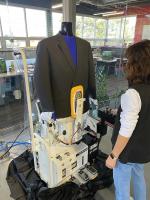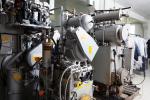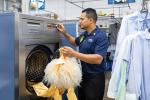CHICAGO — No machine lasts forever, and even those dry cleaners who are handy with tools will have to throw in the towel at some point and replace some of their plant’s equipment. But, with the right questions, cleaners can get a better picture of where the finish line is for the machines that keep their business running.
In Part 1 of this series, we examined topics such as various factors that can lead an owner to contemplate buying new machinery and how to future-proof their investments the best they can. Today, we’ll examine an evergreen question when it comes to dealing with aging equipment.
Repair or Replace?
Time goes by quickly in a fast-paced business, and it’s easy to lose track if you’re not keeping good records. Ary cleaners should take into account both the years and the mileage on their equipment when something breaks down.
“Estimated repairs over that time is key,” says Vic Williams, eastern sales manager for Union Dry Cleaning. “Often, the cost of the parts would be a good down payment on a new machine, and that’s not even considering the freight and the labor needed to get it back up and running.”
“We encourage our customers to take a long-term view of their equipment investments and calculate the total cost of machine ownership over time versus focusing solely on saving budget right now,” says Paulo Rocha, head of sales, HCS Business Unit for Miele Professional. “With the right data, the decision to purchase — or not — becomes much easier.”
With any piece of machinery, says Wesley Nelson, president of Sankosha USA, wear and tear will start to take a toll. Keeping good records will allow a cleaner to better determine if a machine just needs a routine repair or if it’s time to consider retiring it.
“If you look at your records over time, you can see how much money per year or per month is being spent on a particular piece of equipment just to keep it up and running,” he says. “Often, it comes down to a major component on a piece of machinery. If it fails, you then have to balance the possible high cost of that component versus the benefits of buying a new piece of machinery. Sometimes it’s as simple as that.”
The numbers don’t lie, Nelson says: “When the curve starts to point up, then it’s probably a great time to get a new piece of machinery.”
Asking the Right Questions
When making a major purchase, dry cleaners need to ask the supplier or manufacturer any questions they think they need answered to make the best decision for their individual situation.
“When we’re talking to a customer, we want to make sure they’re buying exactly what they need,” Nelson says. “Sometimes they don’t know what they need, but asking some simple questions can help. ‘What are your production numbers on a daily or weekly basis for a certain garment? What kind of garments are you planning to use this machine on? What machine are you currently finishing these garments?’ Just asking those kinds of questions can make sure that what they’re purchasing meets with their expectations.”
“It’s also helpful to ask about the total cost of ownership of the machine,” Rocha says. “This includes things like purchase price, installation, maintenance, and energy costs across the life of the machine.”
And then, there are nuts-and-bolt questions that need to be asked so the cleaner doesn’t get a nasty surprise on delivery day.
“Get the specs of the machine and make sure it’s going to fit in the space in the building,” Williams says. “You may be replacing the same model, but something might have changed. Maybe the machine’s a little taller now and they’ve just barely made it through before. When the machine arrives, you don’t want to see that it’s 2 inches too tall and you can’t get it through the doorway.”
“From a manufacturer’s point of view, you want to make sure the customer has the right utilities in place,” Nelson says. “Do they have the electric supply on hand that they need? Those are questions that need to be answered. Is this machine 110 (volt)? Or 220? How many amps does it need? Knowing these answers, you’re not scrambling around when the machine shows up, and we get a much happier customer.”
Come back Thursday for the conclusion of this series, when we’ll examine some of the benefits of new equipment — as well as some of the hidden costs. For Part 1, click HERE.
Have a question or comment? E-mail our editor Dave Davis at [email protected].


























































